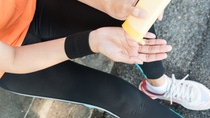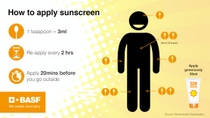Debunking sunscreen myths part 3

We often hear myths around sunscreen like: SPF 30 is only marginally better than SPF 15. The protection factor of SPF 30 is not double that of SPF 15, nor is SPF 60 twice as effective as SPF 30……
The rationale behind this myth is that if SPF 30 can filter out 96.7% of UV rays, while SPF 60 can filter out 98.3%, the resulting difference is only 1.6% - thus SPF 60 must only be marginally better than SPF 30. Actually, this is looking at the situation in the wrong way! When looking at SPF we are not only concerned with how much UV radiation is blocked, but rather how much UV can successfully be transmitted onto our skin to cause damage. If we look at it like this, we see that:
- Sunscreens with SPF 60 allow 1.7% of UV radiation to hit our skin
- Sunscreens with SPF 30 allow 3.3% of UV radiation to hit our skin
Viewed like this, we can see that the 1.6% difference of UV penetration between SPF 60 and SPF 30 is actually doubled. This means that contrary to our third myth, SPF 60 is twice as effective as SPF 30, and SPF 15 is half as effective as SPF 30. All this might be confusing - so if you need, take look at this animation on YouTube[1].
We also tend to advise that consumers pick higher sunscreens that offer higher SPF, because scientists have observed that when consumers don’t typically get all the full SPF factors written on the bottle. Even if one buys a sunscreen with SPF 30, it is unlikely that they do enjoy the full benefits of SPF 30 - it is better for us to aim for a higher SPF.
Why don’t we get the full benefits then? Well, after investigating scientists found that it was because consumers do not normally apply sunscreen in the right way. Often, consumers do not apply the right amount nor do they apply it evenly, reducing the protection the sunscreen offers.
Because consumers do not have the luxury of the specialist knowledge experts possess, it is not surprising that many continue to apply sunscreen incorrectly.
By running statistics and models, scientists found that failure to apply the right amount in an even manner of an SPF 15 sunscreen actually means that SPF 30 sunscreen has twice UV protection, and therefore twice the protection against skin cancer - because we fail to get the full SPF 15 protection[2].
Fact:
To conclude, SPF 30 has twice the UV protection offered by SPF 15. But, this is reliant on applying the right amount and in an even manner. If you’re going to the beach, always remember to bring a sunscreen that has an SPF of at least 50, or 50+, PA ++++! Don’t forget that splashing around in the sea means you should also opt for sunscreens that are water resistant.
We’ve touched on a lot about incorrect methods of application, but most importantly what is the correct method? Well, you should aim for about 2mg/cm2 of skin (this looks like a teaspoon of sunscreen applied to your face). Again, remember to apply it as evenly as you can. Remember, the higher the SPF in a sunscreen, the better chance you have of being properly protected, so remember to reach for the broad spectrum SPF 50+ next time you’re at the pharmacy or supermarket!
*Always read the label, use only as directed

Interested in learning more? Contact us so we can share our insight and expertise in developing solutions for the sunscreen industry.
REFERENCE
1. Osterwalder U., et al. Sun protection factors: worldwide confusion, Brit J. Dermatol 2009;161:13-24; YouTube Animation
2. Pissavini M., et al. The likelihood of sunburn in sunscreen users in disproportionate to the SPF. Photodermatol Photoimmunol Photomed 2013:29:111-115
®/TM Registered trademark. All rights reserved.